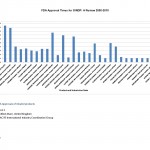A review of FDA approval times for OINDPs presented at the recent IPAC-RS conference verifies that the process has sped up considerably over the last decade. According to the poster authored by Ray Ormiston of IPAC-RS’s Global Regulatory Affairs and Outreach Committee, whereas most of the 20 OINDP submissions from 1992-2003 took 2-3 years for approval, and several nearly 8 years, almost all of the inhalation and nasal product approvals for submissions after 2004 required less than a year.
Using documents available at the Drugs@FDA web site, Ormiston determined approval times for a total of 35 OINDPs approved between 2000 and 2010. Of those products, four – Exubera, Calomist, Zolpimist, and Tyvaso – were approved for systemic action, while the rest were approved for local action.
A bar graph of the approval times for the locally-acting products in order of NDA submission date shows a clear diminution in the length of the process over the course of the decade, with a maximum approval time for applications submitted after 2004 of 14 months. Prior to 2000, all OINDP submissions required at least 2 years for approval, with several applications from the mid-to-late 1990s taking from 76-94 months.
Ormiston points out that the median FDA approval time for all drugs from the mid-1980s to the mid-1990s hovered around 30 months. However, when then commissioner David Kessler led an effort to streamline the process and succeeded in halving approval times for all drugs by 1996, the median for locally-acting OINDPs remained at 30 months through 2004. FDA approval times were also significantly longer than EU approval times for OINDPs, as shown in research presented by Steve Horhota of Boehringer Ingelheim at the 2005 RDD Europe meeting.
The 1998 introduction of the draft guidance for MDIs and DPIs could have contributed to delays, Ormiston notes, given “the extensiveness of the proposed CMC requirements.” In addition, the changeover from CFCs to HFAs as propellants for metered dose inhalers and the rise of dry powder inhalers, both of which began during the 1990s, could account for longer approval times.
According to Ormiston’s research, the FDA is now more in line with the EU when it comes to approving OINDPs. Although the complexity of the factors involved in approval time makes it difficult to attribute the improvements to any one reason, he notes in particular that “Industry sought opportunities to work with FDA to find solutions through more open forums, and FDA has exhibited willingness to work with Industry both during review and beforehand in meetings to improve the situation.”
The current quality by design (QbD) approach, first introduced by the FDA in 2002, may also play a role, he suggests, as “The Pharmaceutical Development section of an NDA has become a core tool for conveying knowledge and supporting the overall control strategy.” Steve Horhota suggests that future submissions will help to determine the true effect of this focus : “As we move more into the QbD paradigm and Enhanced ICH Q8 submissions, it would be interesting to see what happens to the pattern of approval times.”
The FDA declined to comment for this story.



